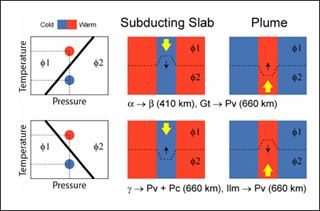
The Clapeyron slopes of mantle phase boundaries and mantle convection. Near a phase boundary with positive Clapeyron slope (top), materials in cold region transform to high-pressure phase (denser) at shallower depth than those in hot region. Instead, near a phase boundary with negative Clapeyron slope (bottom), materials in hot region transform to high-pressure phase (denser) at shallower depth than those in cold region. Therefore, phase boundary together with temperature difference results in density anomaly near phase boundary. (Image by Prof. Sang-heon Shim.)
Instructor(s)
Prof. Sang-Heon (Dan) Shim
MIT Course Number
12.581
As Taught In
Spring 2005
Level
Graduate
Course Description
Course Highlights
This course features assignments and detailed reading list.
Course Description
This course discusses phase transitions in Earth's interior. Phase transitions in Earth materials at high pressures and temperatures cause the seismic discontinuities and affect the convections in the Earth's interior. On the other hand, they enable us to constrain temperature and chemical compositions in the Earth's interior. However, among many known phase transitions in mineral physics, only a few have been investigated in seismology and geodynamics. This course reviews important papers about phase transitions in mantle and core materials.


